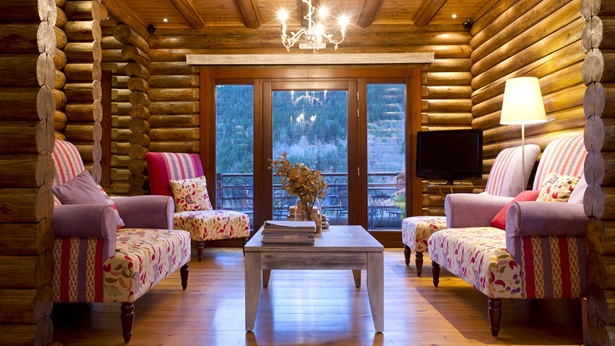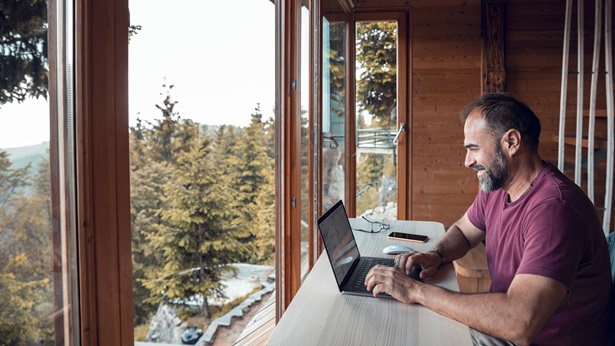Insuring Your Dream Log Home
Like death and taxes, insurance is one of the realities we deal with in modern life. Insuring your new dream log and timber home is not only wise; mortgage lenders and title companies require it to obtain a construction-permanent loan.
Fortunately, in the grand scheme of things, the cost of insurance is a bargain compared to what it provides — peace of mind that your home will be made new again if it is damaged or destroyed. That same kind of peace of mind comes standard when you buy from a member of the Log and Timber Homes Council. Council members have agreed to a set of membership requirements that offer safe guards to homeowners during the buying and building process. Learn more about these safeguards here.
Just as with the construction of a conventional home, your new log and timber home will need insurance before, during and after construction. Because log and timber homes are a niche market, you should shop carefully for a policy that meets your needs. Here are come common questions and answers to ensure you are an educated insurance shopper.
Q: When should I start shopping for log and timber homeowners insurance?
A: Even before you buy and build your dream home. The ultimate price of your insurance premiums will depend on a host of factors (more about that later), but you’ll need to include that cost in your budget. You’ll also need to obtain insurance during construction, called “course of construction” insurance. Today, this type of insurance automatically converts a homeowner’s policy once construction is completed. (In the past it used to be two separate policies.)
Q: Do all insurance companies offer homeowners insurance for log and timber homes?
A: No. Some of the largest nationwide companies do offer policies for log and timber homes, such as State Farm, Met Life, Merrill Lynch, Allied, Farmers, USAA, etc. Other insurance companies may not offer coverage to log and timber homes. It’s not that the companies are singling out log and timber homes; rather, many companies are withdrawing from home insurance altogether because of a dramatic increase in natural disasters (think hurricanes and floods in recent years). Other factors included the high price tag lawsuits for mold damage in conventional homes and problems with drywall from China.
Q: Where should I start shopping for rates?
A: Start with your current agent. Today many agents represent more than one insurance carrier. You can also shop online or ask your builder/dealer and other log and timber homeowners in your community. When you are checking your builder’s references of past clients, ask these log and timber homeowners who they are using, the agent and company and ballpark cost for insurance. Factor this into your budget.
Q: Does log and timber home insurance cost more than conventional stick frame homes?
A: It often depends on where you are building. The cost will be tied to the appraisal value and any risks associated with your location. These factors will be weighed by insurance underwriters when determining your premium.
Q: What type of log and timber homes will be covered?
A: Either handcrafted or milled log and timber homes are insurable, as long as professionals produce the home package. If you chop down your own trees, scribe them and build your home like the pioneers did, you will find it difficult to obtain insurance since underwriters will find it difficult to evaluate your performance as a builder or the value of your home.
Q: Will my building site influence my costs?
A: Yes. If your building site is located in a floodplain, a hurricane, tornado or earthquake-prone area, or a steep slope, you will pay more for insurance. Insurance underwriters also require access to water for fighting a house fire, to limit damage. When determining your risk, your insurance agent will note your home’s proximity to a fire hydrant (up to a thousand feet is acceptable), the distance to a fire station (within five miles is desirable) and whether that station is staffed by professional fire fighters or merely volunteers. All these factors will influence your insurance premiums.
Q What is a ‘fire rating?’
Your building site, community and state are typically given fire ratings, from one to ten, based on the risk of wild fire. The lower the number, the better the rating and the less expensive your premiums will be. If your home is located on the edge of a national forest (meaning lots of fuel) with nothing but well water as a source, then your fire rating and cost will be increased. Some building codes require water storage for fighters to access, such as a pond or cisterns.
Q: What else will influence my insurance premiums?
A: Ever filed an insurance claim or missed a credit card payment? With the Internet and today’s computer capabilities, our lives are an open book to the insurance industry. Our credit rating and our past insurance claim history dramatically influence the rates we pay. This is why your agent will advise you to only file claims where there is serious damage to your home.
Q: Are there ways to reduce insurance costs?
A: Log homeowners may be able to obtain a reduction in their residential insurance premium based on what kind of roofing materials they specify during construction. High impact and fire resistant roofing materials reduce the risk of fire and hail damage. This is why insurance carriers reward homeowners that opt for these products.
Some insurance carriers can also offer discounted premiums for fire sprinkler systems, anti-backflow plumbing devices installed in finished basements to block sewer backups and whole-house surge protection devices to mitigate damage from lightning strikes.
Q: What should I look for in an insurance agent and policy?
A: Chose an agent experienced with insuring log and timber homes. For example, it’s helpful if the agent can understand the different between full log systems (both milled and handcrafted) and half log systems (which are more akin to conventional construction with 2-by-4 or 2-by-6 framing).
Agents familiar with log and timber home construction recommend policies that specify reimbursement of the full replacement value in the event of the home is lost to fire or other natural disaster. Be aware that some insurance carriers leave it up to the homeowner to track the full replacement value of their home each year.
Q: What’s typically not covered by insurance?
- Loss of home from nuclear war.
- Damage done by sewer backup into a finished basement.
- Insect (bees, termites, etc.) infestation.
- Vermin (rats, mice, bats) infestation.
- Wood rot.
- Damage from domestic animals.
- Any other damage that happens from a lack of homeowner maintenance



